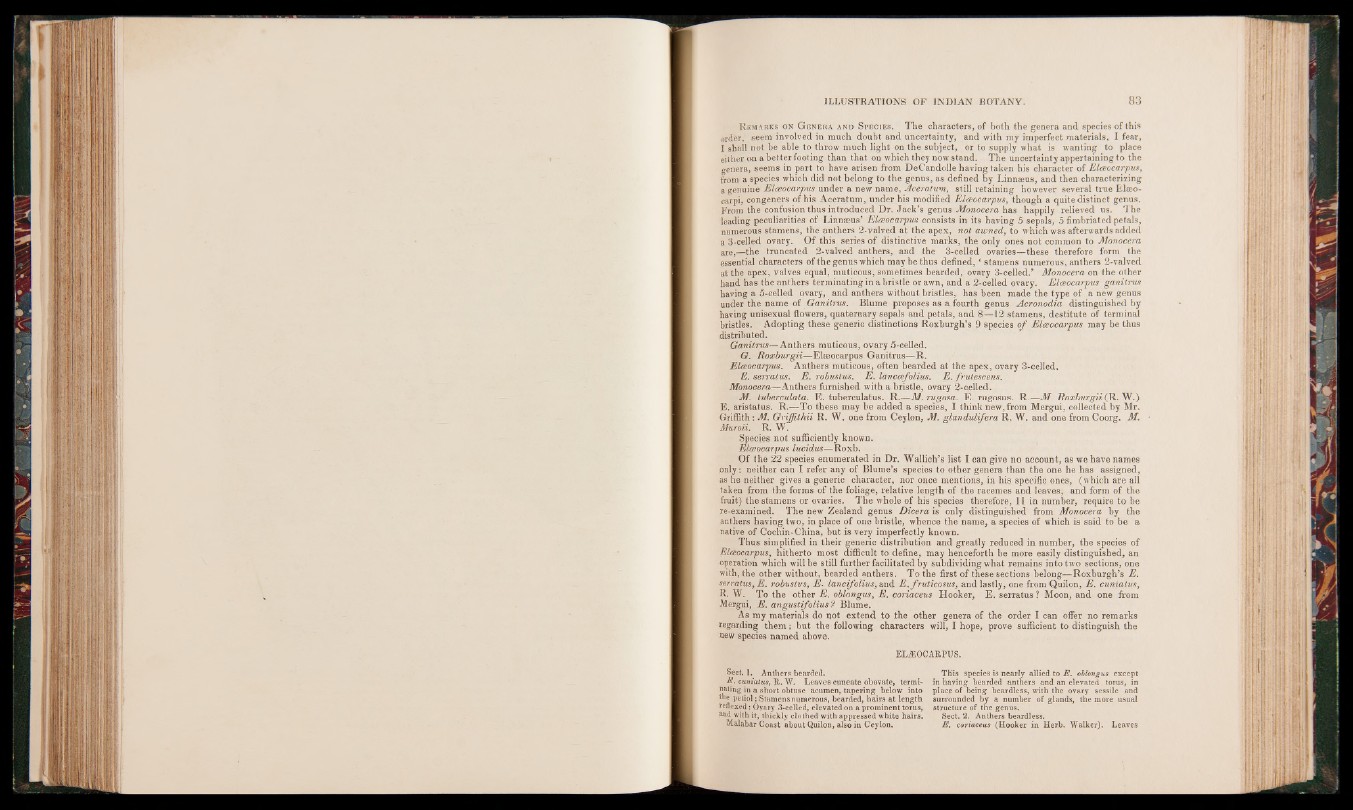
R emarks on G enera and S pec ie s . The characters, of both the genera and species of this
order, seem involved in much doubt and uncertainty, and with my imperfect materials, I fear,
I shall not be able to throw much light on the subject, or to supply what is wanting to place
either on a better footing than that on which they now stand. The uncertainty appertaining to the
genera, seems in part to have arisen from DeCandolle having taken his character of Elceocarpus,
from a species which did not belong to the genus, as defined by Linnaeus, and then characterizing
a genuine Elceocarpus under a new name, Aceratum, still retaining however several true Elaeo-
carpi, congeners of his Aceratum, under his modified Elceocarpus, though a quite distinct genus.
From the confusion thus introduced Dr. Jack’s genus Monocera has happily relieved us. The
leading peculiarities of Linnaeus’ Elceocarpus consists in its having 5 sepals, 5 fimbriated petals,
numerous stamens, the anthers 2-valved at the apex, not awned, to which was afterwards added
a 3-celled ovary. Of this series of distinctive marks, the only ones not common to Monocera
are,—the truncated 2-valved anthers, and the 3-celled ovaries—these therefore form the
essential characters of the genus which may be thus defined, ‘ stamens numerous, anthers 2-valved
at the apex, yalves equal, muticous, sometimes bearded, ovary 3-celled.’ Monocera on the other
hand has the anthers terminating in a bristle or awn, and a 2-celled ovary. Elceocarpus ganitrus
having a 5-celled ovary, and anthers without bristles, has been made the type of a new genus
under the name of Ganitrus. Blume proposes as a fourth genus Acronodia distinguished by
having unisexual flowers, quaternary sepals and petals, and 8—12 stamens, destitute of terminal
bristles. Adopting these generic distinctions Roxburgh’s 9 species o f Elceocarpus may be thus
distributed.
Ganitrus—Anthers muticous, ovary 5-celIed.
G. Roxburgii—Elaeocarpus Ganitrus—R.
Elceocarpus. Anthers muticous, often bearded at the apex, ovary 3-celled,
E. serratus. E. robustus. E. lanccefolius. E. frutescens.
Monocera—Anthers furnished with a bristle, ovary 2-celled.
M. tuberculata. E. tuberculatus. R.—M.rugosa. E. rugosus. R.—M. Roxburgii (R. W.)
E. aristatus. R.—To these may be added a species, I think new, from Mergui, collected by Mr.
Griffith: M. Griffithii R. W. one from Ceylon, M. glandulifera R, W. and one from Coorg. M.
Muroii. R. W.
Species not sufficiently known.
Elceocarpus lucidus—Roxb.
Of the 22 species enumerated in Dr. Wallich’s list I can give no account, as we have names
only: neither can I refer any of Blume’s species to other genera than the one he has assigned,
as he neither gives a generic character, nor once mentions, in his specific ones, (which are all
taken from the forms of the foliage, relative length of the racemes and leaves, and form of the
fruit) the stamens or ovaries. The whole of his species therefore, 11 in number, require to be
re-examined. The new Zealand genus Dicera is only distinguished from Monocera by the
.anthers haying two, in place of on,e bristle, whence the name, a species of which is said to be a
native of Cochin-China, but is very imperfectly known.
Thus simplified in their generic distribution and greatly reduced in number, the species of
Elceocarpus, hitherto most difficult to define, may henceforth be more easily distinguished, an
operation which will be still further facilitated by subdividing what remains into two sections, one
with, the other without, bearded anthers. To the first of these sections belong—Roxburgh’s E.
serratus, E. robustus, E. lancifolius, and E.fruticosus, and lastly, one from Quilon, E. cuniatus,
R. W. To the other E. oblongus, E. coriaceus Hooker, E. serratus ? Moon, and one from
Mergui, E. angustifolius ? Blume.
As my materials do not extend to the other genera of the order I can offer no remarks
regarding them; but the following characters will, I hope, prove sufficient to distinguish the
hew species named above.
ELiEOCARPUS.
Sect. I. Anthers bearded.
E . cuniatus, R. W. Leaves cuneate obovate, termi-
nating in a short obtuse acumen, tapering below into
the petiol; Stamens numerous, bearded, hairs at length
reflexed: Oyary 3-celled, elevated on a prominent torus,
9-nd with it, thickly clothed with appressed White hairs.
Malabar Coast about Quilon, also in Ceylon.
This species is nearly allied to E . oblongus except
in having bearded anthers and an elevated . torus, in
place of being beardless, with the ovary sessile and
surrounded by a number of glands, the more usual
structure of the genus.
Sect. 2. Anthers beardless.
E . coriaceus (Hooker in Herb. Walker). Leaves